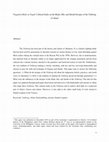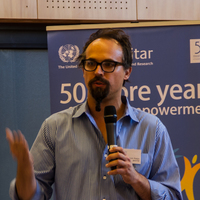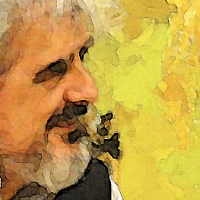Drafts by Theodore Ricardo Bautista

The Talibong has been part of the history and culture of Aklanons. It is a distinct fighting blad... more The Talibong has been part of the history and culture of Aklanons. It is a distinct fighting blade that has been used by generations of Akeanon warriors in various theatres of war, from defending against Moro raiders during the colonial times to the Korean War in the 1950s. However, due to modernization, this material form of Akeanon culture is no longer appreciated by the younger generation and has been reduced into a distant memory attached to the primitive and backward notion of rural life. Furthermore, the very tradition of Talibong making is slowly vanishing, with less and less surviving bladesmiths and artisans to pass the skill and technique of forging such blades. This paper aims to answer the following questions: 1.) What do the designs of the Talibong tell about the indigenous beliefs, practices, and world views of Akeanons? 2.) How is the tradition of making the Talibong preserved through generations? 3.) What were the influences in the designs of the blade, hilt, and sheath of the Talibong? The data for this paper was gathered through participant observation and interviews with bladesmiths and artisans in Aklan who made these Talibong. This cultural study on the Talibong and its makers shed light on a neglected part of Aklan's history and culture. Moreover, it also adds to the rather small body of work related to bladed weapons in the Visayas.
Visayan Studies 101 (VS101) - University of the Philippines Visayas, 2020

University of the Philippines Visayas, 2019
Communities that lie along the banks of the Aklan River have always faced various challenges beca... more Communities that lie along the banks of the Aklan River have always faced various challenges because of its strong currents and unpredictable nature. Further upstream, however, the peoples in the remote settlements of Libacao and Madalag continue their way of life despite the upstream being the most violent parts of the river. Very little have been written on the beliefs and practices of these upstream settlements; their cultures of coping, adapting, and surviving. The people of the lowlands may have much to learn about the indigenous skills and knowledge of these people from the upstream area, valuable lessons in coping with the ever changing environment. This study emphasizes the role of these beliefs in minimizing the dangers and hazards brought about by the strong currents of Aklan River. Overall, this study aims to answer the following questions: 1.) What are the beliefs and practices of the people in Libacao and Madalag regarding the Akean river (e.g. myths, legends, supernatural forces)? 2.) How are these beliefs and practices used by the people of Libacao and Madalag to cope with the strong currents of the upstream Akean River? 3.) How are these beliefs and practices of the people living in the communities along the upstream Akean River preserved through time? For data gathering, the study makes use of first-hand information about these beliefs and practices which are derived from key informants of the upstream settlements in Libacao and Madalag. The study of the beliefs and practices (regarding the Aklan River) of these upstream settlements in Libacao and Madalag can shed light to their often misunderstood and neglected cultures. In a broader sense, the study of these traditional ways of coping by upstream communities in Aklan is significant in understanding the ways by which hazardous environments have shaped their history and culture and on how these cultures of coping are maintained and passed to succeeding generations.
Papers by Theodore Ricardo Bautista

Contemporary Chinese Political Economy and Strategic Relations, 2022
Since Ukraine’s secession from the Union of Soviet Socialist Republics (USSR) and subsequent decl... more Since Ukraine’s secession from the Union of Soviet Socialist Republics (USSR) and subsequent declaration of its independence more than three decades ago, Russia’s stance toward the former Soviet republic has always been one of non-recognition, territorial encroachment, political intervention, and a policy of low-intensity conflict. The Russian military actions in Ukraine has become the most serious conflict in Europe after the Second World War. The crisis in Ukraine further presented a significant strategic challenge to the Chinese leadership in global politics. The international community has likewise turned to the Chinese doorstep as many perceived its behavior as the reflection of what they call the “China’s dilemma” in the on-going crisis. Within this premise, this paper looks into China’s strategic diplomatization in securitizing and balancing its geopolitical and economic interests.











Uploads
Drafts by Theodore Ricardo Bautista
Papers by Theodore Ricardo Bautista